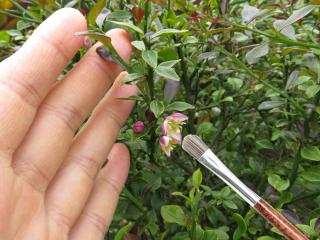

Australian finger lime is a delicious citrus fruit that’s easy to grow as an indoor plant. It’s sometimes difficult to get it to bear fruit and keep them from dropping. But in the end, you’ll get a great harvest!
Read also:
Your first questions are often going to show your eagerness: when will my little tree bear those delicious fruits? Then, dismay – why are they falling off? And finally, the joy of a bountiful harvest!
After 3 to 5 years, young trees will start bearing flowers. At first, there are heavy losses, so expect massive fruit drop in the first two seasons.
The harvest increases significantly after 2 years of fruit-bearing.
Usually trees are from grafted stock to make sure they grow and bear expected fruits. Grafting tricks the sapling into thinking it’s older than it actually is.
In the very best conditions, only 60 to 70% of flowers will “set” or start turning into fruits.
Pollination is normally the work of bees and other insects.
The citrus family readily cross-pollinates. This means your finger lime flowers can receive pollen from other citrus species if they’re nearby – provided they produce fertile pollen. Luckily, this is often the case: most citrus varieties, from calamondin to kumquat, aren’t sterile.
To hand pollinate finger lime, a small paintbrush with soft strands is needed:
 simply swipe the brush delicately around the inside of each flower, one after the other
simply swipe the brush delicately around the inside of each flower, one after the otherSo now you’re on track to have lots of little fruits appear – how do you make sure they mature? Read on!
Microcitrus austalasica often drops many of its fruits at the slightest sign of stress.
Keeping the soil around the tree slightly moist is essential to reduce fruit drop.
It is normal for a certain amount of fruits to drop. Abundance is nature’s way of sharing to other species while still ensuring reproduction. It’s common to see up to half of set fruits start dropping.
Harvest season is usually November to March. Depending on variety and growing conditions, it can take up to 10 months for a finger lime fruit to ripen.
You will ensure the finger limes mature best by protecting the tree from freezing.
An adult tree, properly pruned, can produce up to 45 lbs (or 20 kg) of fruit a year.
The fruit on my Australian finger lime tree is black. ?
Why healthy 10yr old seedling finger lime tree not bearing fruits. Few years ago it produced few fruits.